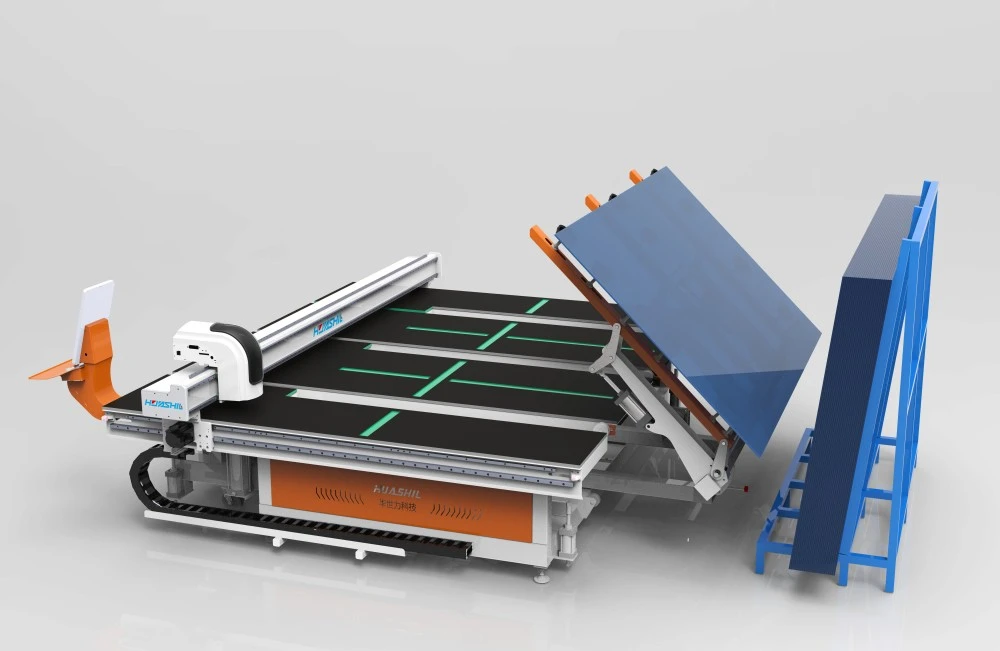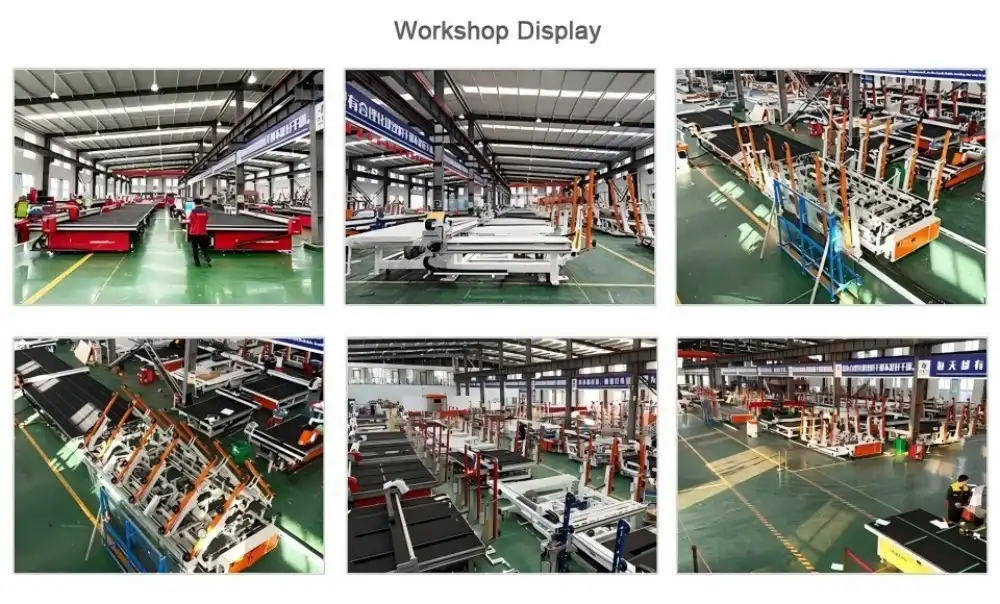In the world of glass fabrication, the choice between CNC (Computer Numerical Control) and manual cutting machines is a crucial decision that can significantly impact productivity, precision, and overall business success. Both methods have their merits, and selecting the right approach depends on various factors. This comprehensive guide will explore the pros and cons of CNC and manual cutting machine for glass, helping you make an informed decision for your glass cutting needs.
Efficiency comparison: CNC and manual methods
When it comes to efficiency, CNC and manual glass cutting methods have distinct differences:
CNC cutting machines offer unparalleled speed and consistency. These automated cutting machine for glass can process multiple glass sheets simultaneously, significantly reducing production time. The computer-controlled precision ensures each cut is identical, minimizing errors and waste. Additionally, CNC cutting machine for glass can operate continuously, allowing for 24/7 production capabilities.
Manual cutting, on the other hand, relies on the skill and experience of the operator. While a seasoned professional can achieve impressive results, the process is inherently slower and more prone to human error. Each piece must be measured and cut individually, which can be time-consuming, especially for large-scale projects.
However, manual cutting does have its advantages in certain scenarios. For small, custom jobs or intricate designs that require a human touch, manual cutting can be more flexible and cost-effective. It allows for on-the-spot adjustments and immediate quality control, which can be beneficial for unique or specialized projects.
In terms of throughput, CNC cutting machine for glass have a clear edge. They can process hundreds of glass pieces per hour, maintaining consistent quality throughout. This high-volume capability makes them ideal for large-scale manufacturing and standardized production runs.
Manual cutting, while slower, can be more adaptable to changing requirements. Operators can quickly switch between different thicknesses or types of glass without the need for reprogramming, which can be advantageous for workshops that handle a variety of small jobs.

Cost-benefit analysis for different project scales
The cost-benefit analysis of CNC versus manual glass cutting varies significantly depending on the scale and nature of your projects:
For large-scale operations, the initial investment in a CNC glass cutting machine can be substantial. However, the long-term benefits often outweigh the upfront costs. These machines offer:
- Reduced labor costs due to automation
- Minimized material waste through precise cutting
- Increased production capacity
- Consistent quality, leading to fewer rejections and customer complaints
Over time, these factors contribute to a higher return on investment (ROI) for businesses with high-volume production needs.
For smaller operations or those with diverse, low-volume projects, manual cutting may be more economically viable. The lower initial investment and flexibility of manual cutting machine for glass can be advantageous. However, it's important to consider the potential limitations in terms of production capacity and the reliance on skilled labor.
Mid-sized businesses may find a hybrid approach beneficial, utilizing both CNC cutting machine for glass and manual cutting methods. This allows for the efficiency of CNC for larger runs while maintaining the flexibility of manual cutting for custom work.
When analyzing costs, consider not only the equipment but also factors such as:
- Training requirements for operators
- Maintenance and repair costs
- Energy consumption
- Space requirements
- Potential for future expansion
It's crucial to project your business growth and assess how each cutting method aligns with your long-term goals. While CNC machines may seem like a significant investment initially, they can provide scalability and efficiency that manual methods cannot match as your business expands.
When to choose manual over CNC cutting?
Despite the many advantages of CNC technology, there are situations where manual glass cutting remains the preferred choice:
Specialized or artistic projects: For unique, one-off designs or artistic glass pieces, the intuition and craftsmanship of a skilled artisan using manual techniques can be irreplaceable. The human touch allows for subtle adjustments and creative decisions that a machine cannot replicate.
Small batch production: When dealing with very small quantities or prototype runs, setting up a CNC machine may not be time or cost-effective. Manual cutting can be quicker and more straightforward for these limited production scenarios.
On-site or mobile work: In situations where glass cutting needs to be done on-site or in varying locations, portable manual cutting machine for glass offer greater flexibility compared to large, stationary CNC machines.
Budget constraints: For startups or small businesses with limited capital, investing in manual cutting machine for glass and relying on skilled craftsmanship can be a more accessible entry point into the glass cutting industry.
Rapid prototyping: When quick iterations and immediate adjustments are necessary, manual cutting allows for instant modifications without the need for reprogramming or setup changes.
Education and training: Manual cutting machine for glass techniques are fundamental to understanding glass properties and behavior. For educational purposes or training new professionals, hands-on experience with manual methods is invaluable.
Restoration work: Historical restoration projects often require matching old techniques and materials. Manual cutting machine for glass methods may be more appropriate for replicating traditional craftsmanship.
Complex shapes with low repeatability: For intricate designs that are not frequently repeated, the time invested in programming a CNC cutting machine for glass may outweigh the benefits, making manual cutting more efficient.
It's important to note that even in a CNC-dominated workshop, maintaining manual cutting skills can be beneficial. It provides a backup for unexpected machine downtime and allows for quick adjustments or small jobs without disrupting the main production line.
The decision between CNC and manual cutting often isn't an either/or choice. Many successful glass fabrication businesses maintain both capabilities, leveraging the strengths of each method to meet diverse client needs and market demands.
When considering manual cutting, invest in high-quality cutting machine for glass and prioritize ongoing training for your operators. The skill of your craftspeople can be a significant differentiator in the market, especially for custom or high-end work.
Remember that the glass industry is continually evolving, with new materials and design trends emerging. Manual cutting machine for glass skills can be crucial in adapting to these changes quickly, as they allow for experimentation and innovation that may not be immediately possible with CNC systems.
Ultimately, the choice between CNC and manual cutting should align with your business model, client base, and long-term strategic goals. By carefully assessing your specific needs and market position, you can make an informed decision that balances efficiency, quality, and cost-effectiveness.

Conclusion
The debate between CNC and manual cutting machine for glass is not about declaring an absolute winner, but rather about finding the right fit for your specific needs. CNC machines excel in high-volume production, precision, and consistency, making them ideal for large-scale operations and standardized products. Manual cutting, with its flexibility and lower initial costs, remains valuable for custom work, small batches, and specialized applications.
As you consider your options, think about your current needs and future growth potential. Many successful businesses in the glass industry find that a combination of both methods provides the best of both worlds – the efficiency of CNC for large projects and the artisanal touch of manual cutting for unique pieces.
At Shandong Huashil Automation Technology Co., LTD, we understand the complexities of choosing the right glass cutting solution for your business. With years of experience in automated R&D, manufacturing, and sales of mechanical equipment, we're uniquely positioned to help you make the best decision for your specific needs. Our advanced techniques, stable quality, and excellent service have made us a trusted partner for customers worldwide.
Ready to elevate your glass cutting capabilities? Whether you're looking to invest in a state-of-the-art CNC glass cutting machine or seeking advice on optimizing your current setup, we're here to help. Contact our expert team at salescathy@sdhuashil.com to discuss how we can tailor our solutions to your unique requirements. Let's work together to enhance your productivity and product quality in the competitive glass fabrication industry.
References
1. Johnson, M. (2022). "Advancements in Glass Cutting Technology: CNC vs. Manual Methods." Journal of Glass Manufacturing, 45(3), 178-195.
2. Smith, A. & Brown, L. (2021). "Cost-Benefit Analysis of Automated Glass Cutting Systems in Modern Fabrication." International Glass Review, 18(2), 56-72.
3. Lee, S. et al. (2023). "The Role of Manual Glass Cutting in the Age of Automation: A Case Study Approach." Craftsmanship in Industry, 29(4), 301-318.
4. García, R. (2022). "Efficiency Metrics in Glass Processing: Comparing CNC and Traditional Cutting Techniques." Industrial Automation Quarterly, 37(1), 89-104.



